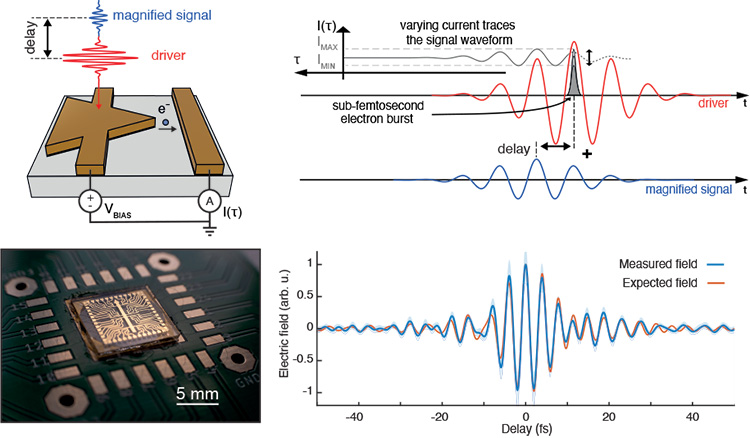 Top left: Schematic of the device. Top right: Depiction of the optical-field sampling process. Bottom left: Photograph of the nanocircuit embedded on a printed circuit board. Bottom right: measured field (blue) compared with reconstructed expected field (red). [Adapted from M.R. Bionta et al., Nat. Photon. 15, 456 (2021)]
Top left: Schematic of the device. Top right: Depiction of the optical-field sampling process. Bottom left: Photograph of the nanocircuit embedded on a printed circuit board. Bottom right: measured field (blue) compared with reconstructed expected field (red). [Adapted from M.R. Bionta et al., Nat. Photon. 15, 456 (2021)]
Light-based techniques for characterizing samples are powerful tools for science and applications. Ideally, these techniques enable measurements with superior spatial and temporal resolution without damaging the sample. Yet, while advances in super-resolution microscopy enable non-destructive imaging with subwavelength spatial resolution, high-sensitivity measurements with temporal resolution better than the cycle time of visible and infrared light remain challenging.
This challenge limits our ability to explore many important light–matter interaction dynamics. For instance, the transfer of energy from light to electrons in photovoltaics and photosynthetic systems occurs on femtosecond and potentially sub-femtosecond timescales. Visualizing such fast dynamics requires temporal resolution on the order of a few femtoseconds or less. The methods for achieving such resolution require large, high-power lasers, vacuum environments or extreme ultraviolet light, severely limiting applications.
To overcome these limitations, we have developed a compact, integratable sampling technology1 that measures visible to near-infrared optical electric-field waveforms directly in the time domain. This technology achieves sub-optical-cycle, sub-femtosecond resolution using only picojoule-level pulse energies. Since the time and frequency domains are correlated by a Fourier transform, complete spectral information (both amplitude and phase) is also retrieved from these measurements.
To measure optical fields with sub-cycle resolution, our devices use arrays of electrically connected resonant nanoantennas2 in combination with few-cycle optical driver pulses. These nanoantennas enhance the driver’s incident optical fields to achieve strong-field photoemission, creating attosecond electron bursts that enable petahertz-level sampling bandwidths. Scanning a weak electric field from a signal wave of interest across the device in time causes a change in the detected current depending on the direction of the signal field. The current then flows out through the devices to an external detector, where it is recorded—providing a perfect replica of the signal wave in time.
Similar time-domain spectroscopy systems operating in the THz regime3 are commercially available, and are commonly used for industrial and scientific applications such as chemical and material analysis. Such systems often prove superior to conventional frequency-domain techniques, but have not yet scaled to the visible and near-infrared regions due to fundamental technology limitations. We believe the our method will provide a compact platform enabling sub-cycle characterization of low-energy optical electric-field waveforms for time-resolved spectroscopy and imaging in the visible to near-infrared. That platform could, in our view, enable new insight into light–matter interaction dynamics, with applications in areas such as photovoltaics, biology, medicine, food-safety, gas sensing and drug discovery.
Researchers
Mina R. Bionta, Marco Turchetti, Yujia Yang, Dario Cattozzo Mor, Karl K. Berggren and Phillip D. Keathley, Massachusetts Institute of Technology, Cambridge, MA, USA
Felix Ritzkowsky and Franz X. Kärtner, Deutsches Elektronen Synchrotron (DESY) and Center for Free-Electron Laser Science, Hamburg, Germany
William P. Putnam, University of California, Davis, CA, USA
References
1. M.R. Bionta et al. Nat. Photon. 15, 456 (2021).
2. Y. Yang et al. Nat. Commun. 11, 3407 (2020).
3. M. Tonouchi, Nat. Photon. 1, 97 (2007).

